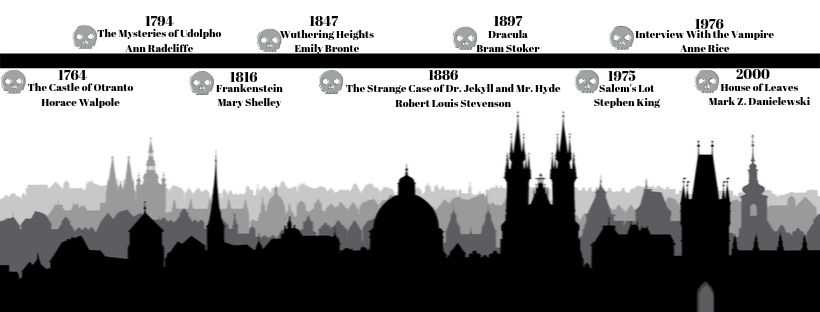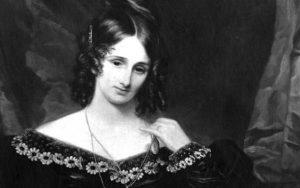One of the first things I remember being read to me was The Raven by Edgar Allan Poe. I was so young, and the language was so unlike anything ever spoken to me, that my grasp of the actual story was tenuous at best. But I knew the bleak December, I saw the stately Raven, I heard the whispered word, “Lenore”, and I felt the deep, unsettling grimness that I would much later come to recognize as the cornerstones of Gothic literature.
 I’ve been a raving fan of the genre pretty much ever since, and it was my Dad who decided such tales made for great bedtime reading, so I guess I come by it honestly.
I’ve been a raving fan of the genre pretty much ever since, and it was my Dad who decided such tales made for great bedtime reading, so I guess I come by it honestly.
To understand Gothic literature fully, it’s best to start with an explanation of Romanticism, which was the movement of the 1800s during which emotion and individualism were top of mind for musicians, artists, and writers. To the modern reader, this seems so obvious that it’s difficult to imagine a time when such themes weren’t employed in artistry and entertainment. But we weren’t here for the influences of the Renaissance, Neoclassical, or Revolutionary periods that came before, which focused heavily on things like mythology and humanism, logic and reason, and freedom and innovation respectively.
So Romanticism really shook things up and some of the first bohemians were born. The artists and consumers were spiritual, sensitive, intuitive, self-aware, and sometimes rustic idealists. It may seem like quite the leap from this sunny style to Gothic literature, but in fact, preoccupation with the things that make us feel a happy contentment transitioned seamlessly into preoccupation with things that make us feel dread.
Horace Walpole is credited with writing the very first Gothic novel in 1764. With The Castle of Otranto, Walpole aimed to combine medieval romance with more modern literature, merging the too fanciful and the uncompromisingly real together into something that could be appreciated by all. This in and of itself is a literary convention that has stood the test of time.
An interesting development not long after the birth of the genre was the introduction of the female Gothic. Pioneers like Ann Radcliffe, Mary Shelley, and the Bronte sisters latched on to this emerging trend out of a hunger to bring feminine perspectives on things like sexual desire and male tyranny into the fold, taboos be damned.
That’s the genesis story of this particular style of literature, but what exactly is it? There doesn’t seem to be a winning definition of Gothic literature among scholars. There are subgenres, and elements the experts on the matter don’t agree on, characteristics that by themselves don’t make a novel Gothic, but in combination do, arguable atmospheric requirements, etc. I must confess that the more I researched the topic, the more uncertain I became that this was something I could write about with any sort of authority. I read individuals with infinitely more expertise than I ramble on for paragraphs about how this or that doesn’t fit the Gothic “tradition” without ever actually revealing what the Gothic tradition is other than to say, “Well, I’ll tell you what it’s not: TRUE BLOOD!” /rage blackout
As hilariously vague as I found these ravings, I have to concede that the presence of vampires, or ghosts, or any other creepy character does not a Gothic novel make. There are a few almost unanimously agreed upon tangible elements of Gothic literature including but not limited to: large, creepy, rundown houses, gloomy weather, distressed damsels, and anti-heroes. But the true essence of Gothic seems to lie more in the intangibles. The feelings evoked as you’re reading. A sense of fear and trepidation about real surroundings and circumstances that come around to serving as a metaphor for the state of mind of the characters.
Take these examples: Sharp Objects by Gillian Flynn is considered southern Gothic, despite the absence of those elements you can see and touch in the story. The protagonist, however, is a tortured, lonely anti-hero and the setting is a small, isolated town. Both lend themselves to the oppressive atmosphere of the story and to the conclusion that it is Gothic.
Then there is the cult classic Twin Peaks, dubbed as suburban Gothic, due to its setting in rainy, bleak Washington state, a general sense of foreboding, dream sequences, and David Lynch's unique style that is just plain hard to put a finger on.
Wuthering Heights is a classic Gothic novel. A supernatural event sets the story off, a large estate full of secrets plays a central role in the plot, and the overall cadence of the tale is one of loneliness, doomed love, and ultimately bitter vengeance.
There are many literary pundits who claim that the Gothic novel is in the middle of a resurgence. Not a comeback, because it never really went anywhere, but an evolution and resulting boost in popularity. There are a few reasons for this. One, things like crumbling infrastructure and increasingly bleak attitudes about the state of the world have already inspired a spike in dystopian literature, and parallels between a dystopia and the atmosphere of a Gothic novel can certainly be drawn. Secondly, the Gothic has long been associated with female empowerment, and support of feminine agency is thankfully on the rise.
It's clear that the Gothic has generational staying power, and many modern authors are bending the "rules" but mostly staying true to a maddeningly nuanced tradition. The classics of the genre set a precedent for certain elements, such as the looming, mysterious manor house, but they also instilled in readers and writers of the time (and also of the future) the idea that the Gothic cannot be nailed down. I think of the definition as something cloaked in darkness, with discernible edges but only obscure shadows in the middle. It can be gloomy, frightening, macabre, eerie, lonely, bitter, sad. It's not a cliched character, or a campy setting, but rather the emotional journey of the reader and the impression that is left as you turn the last page. And since that is entirely subjective, one could claim that the Gothic is in the eye of the beholder.
Check out this list and discover some of the best Gothic novels in LPL's collection.
-Leah Newton is a Readers' Services Assistant at Lawrence Public Library.




Add a comment to: The Gothic (Sort Of) Explained